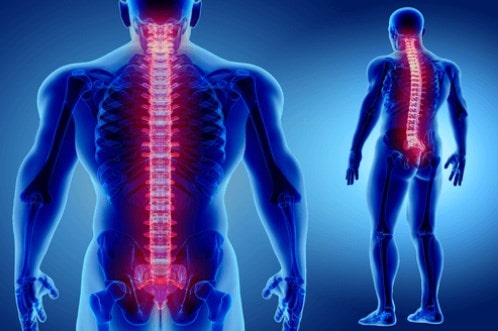
Transverse Myelitis is a neurological disorder associated with inflammation of the spinal cord. “Mielitis” significa inflamación de la médula espinal y “Transversa” se refiere al hecho de que se ve afectada toda la sección transversal del segmento respectivo de la médula espinal.
It belongs to a group of neuroimmune disorders. Inflammation in the spinal cord leads to demyelination and reduces nerve function. As a result, patients suffer from sensory disorders, or vegetative engines.
Myelitis is a rare disease of the nerves, which occurs mainly between the ages of 10 a 19 years and 30 a 49 years. Men and women are affected equally. Inflammation of the spinal cord also occurs in animals.
Myelin plays an important role in the transmission of electrical signals in the central nervous system. In the case of Transverse Myelitis, transmission speed is significantly reduced. This is a relatively rare disease.
Learn more about this disease, here we will tell you its main causes, diagnosis, symptom, treatment and complications. This sickness can start at any age, that is why it is important to know about it and recognize its main characteristics.
Index
Causes of Transverse Myelitis
Myelitis can occur individually or in connection with other diseases. In cases where the disease occurs alone and without a recognizable cause, there is talk of idiopathic cases. An abnormal activation of the immune system, which is then directed against the spinal cord, seems to be responsible for this.
A Transverse Myelitis often develops in connection with bacterial or viral infections, like chickenpox, measles, rubella, mumps and flu. Pathogens damage the spinal cord by directly penetrating there.
Polio, shingles and the HIV virus can also cause myelitis. In addition to bacterial pathogens such as mycoplasma pneumoniae, Lyme's desease, syphilis and tuberculosis. Vaccines can also cause myelitis and there is talk of postvaccinal myelitis, that increases after vaccinations against rabies and typhoid fever.
This neurological disorder rarely occurs in conjunction with autoimmune diseases such as sarcoidosis or multiple sclerosis.. What's more, Transverse Myelitis may be due to spinal artery thrombosis, since the spinal arteries are responsible for supplying blood to the spinal cord.
Diagnosis
Due to the rarity of the disease and the variety of symptoms, diagnosis is often challenging for clinicians, which begins with a medical history and an in-depth physical exam.
In general, a medical history and physical examination performed by the doctor or specialist at the hospital still do not provide clear indications of myelitis or the causes of spinal cord damage.
The MRI of the spinal cord and brain is the method of choice to detect the inflammation characteristic of Transverse Myelitis and rule out other causes of the symptoms, like tumors, herniated discs or other neurological diseases.
If the MRI does not allow a clear diagnosis, a myelography. This is an x-ray exam in which a dye is injected during a lumbar puncture.. Blood tests and cerebrospinal fluid analysis are used to detect signs of inflammation and rule out other diseases..
The course of the disease largely depends on the circumstances of the individual case.. If the treatment is timely, most patients will make a full recovery. Nevertheless, recovery is long and can take months or years.
Symptoms of Transverse Myelitis
The symptoms of Transverse Myelitis depend largely on the affected area of the spinal cord.. The first symptoms appear in a matter of hours or weeks after the onset of the disease.
Symptoms can be very different. The location of the inflammation in particular is responsible for the clinical picture. It is important for symptoms, the affected level of the spinal cord and the extent to which nerve cells and the myelin cortex are damaged.
In about half of those affected, inflammation peaks within the first day. Complaints arise because there are motor neurons in the spine, who can no longer perform their job properly.
When the exchange of information between the periphery of the body is altered, like the limbs and the brain. Affected people suffer from emotional disturbances and back pain.
If the course is severe, the bladder and rectum will malfunction. The first sign of Transverse Myelitis is usually a increasing feeling of weakness in the legs. Weakness can also occasionally occur in the arms. There is a loss of sensation below the affected segment of the spinal cord.
Sexual dysfunctions are often seen in connection with this disease. With severe forms, muscle weakness becomes paraplegia or spastic paralysis. hypersensitivity to cold, warmth and touch, are also common symptoms of this disease.
Treatment
Successful treatment of the disease largely depends on how quickly it is diagnosed.. The corticosteroids are typically used to treat inflammation of the spinal cord in patients with Transverse Myelitis.
The plasma exchange used as a treatment to suppress the immune system. Rehabilitation, especially the physiotherapy, It's fundamental. Patients should prepare for a rehabilitation program that matches that of spinal cord injury.
An intensive rehabilitation phase follows after completion of the acute drug therapy. Regeneration therapy is mainly focused on healing spinal cord damage and physical rehabilitation.
Physiotherapy is also used to counteract muscle weakness, spasticity and incoordination. In some cases, physical therapy is used with heat treatments and baths against pain and motor deficiencies. Many patients suffer from mental stress, like anxiety and depression. Here the doctor advises psychological help additional.
Complications
If Transverse Myelitis is left untreated for a long period of time, May cause serious complications. Emotional disturbances will appear first and back pain will increase. A malfunction of the urinary bladder and rectum will also begin..
With increasing disease, the feeling of weakness in the legs will become more acute causing severe movement disorders. In isolated cases, this symptom also occurs in the arms. Negative progression can cause spastic paralysis to paraplegia.